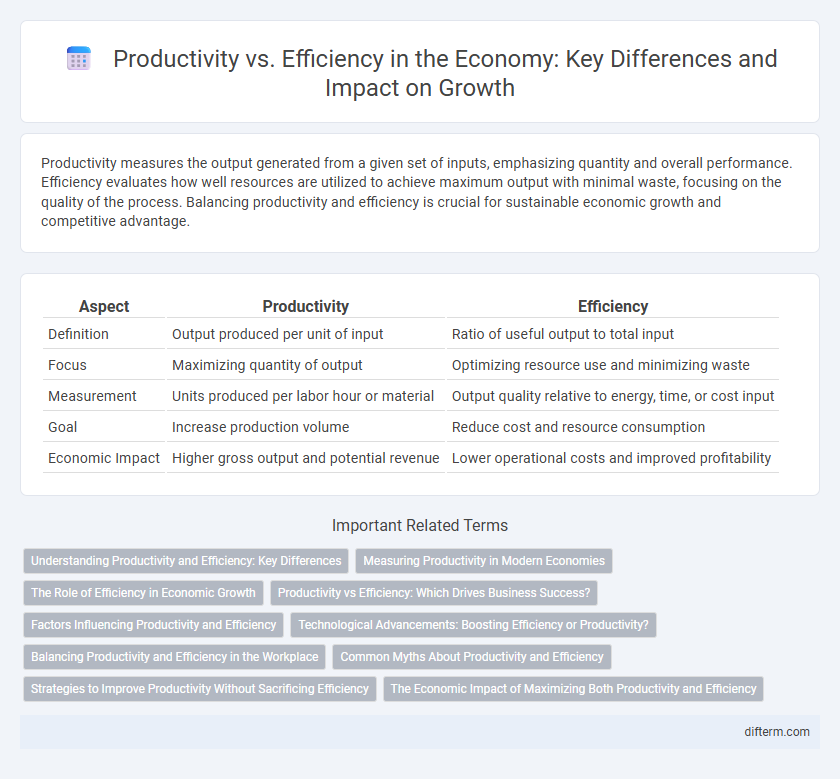Productivity measures the output generated from a given set of inputs, emphasizing quantity and overall performance. Efficiency evaluates how well resources are utilized to achieve maximum output with minimal waste, focusing on the quality of the process. Balancing productivity and efficiency is crucial for sustainable economic growth and competitive advantage.
Table of Comparison
| Aspect | Productivity | Efficiency |
|---|---|---|
| Definition | Output produced per unit of input | Ratio of useful output to total input |
| Focus | Maximizing quantity of output | Optimizing resource use and minimizing waste |
| Measurement | Units produced per labor hour or material | Output quality relative to energy, time, or cost input |
| Goal | Increase production volume | Reduce cost and resource consumption |
| Economic Impact | Higher gross output and potential revenue | Lower operational costs and improved profitability |
Understanding Productivity and Efficiency: Key Differences
Productivity measures the output produced relative to input resources, emphasizing the quantity of goods or services generated. Efficiency evaluates how well resources are utilized to achieve desired results, focusing on minimizing waste and optimizing processes. Understanding these distinctions helps businesses improve operational performance and sustain competitive advantage in dynamic economic environments.
Measuring Productivity in Modern Economies
Measuring productivity in modern economies involves analyzing output per labor hour, total factor productivity, and technological advancements impacting production processes. Data on GDP growth, labor input, and capital utilization provide critical insights into how efficiently resources are converted into goods and services. Advanced metrics such as multifactor productivity indexes enable economists to assess the dynamic interplay between labor, capital, and innovation in driving overall economic performance.
The Role of Efficiency in Economic Growth
Efficiency in resource allocation significantly boosts economic growth by maximizing output from available inputs, reducing waste, and lowering production costs. Higher efficiency enhances competitiveness, enabling economies to produce more goods and services with the same capital and labor, thus driving GDP growth. Firms that prioritize process optimization and technological innovation contribute to sustained increases in productivity and overall economic performance.
Productivity vs Efficiency: Which Drives Business Success?
Productivity measures the output produced per unit of input, while efficiency assesses how well resources are utilized to achieve that output. High productivity alone can lead to increased revenue, but without efficiency, costs may spiral, undermining profitability. Balancing productivity with efficiency drives sustainable business success by maximizing output and minimizing resource waste.
Factors Influencing Productivity and Efficiency
Factors influencing productivity include technological advancements, skilled labor quality, and capital investment, which drive output growth. Efficiency depends on resource allocation, process optimization, and minimizing waste, directly impacting cost reduction and operational performance. Both productivity and efficiency are shaped by management practices, workplace environment, and innovation adoption to maximize economic output.
Technological Advancements: Boosting Efficiency or Productivity?
Technological advancements primarily enhance efficiency by automating repetitive tasks, reducing errors, and optimizing resource allocation, which lowers operational costs. These innovations also drive productivity growth by enabling faster production cycles and facilitating innovation through improved data analytics and communication tools. Firms investing in cutting-edge technologies typically experience simultaneous gains in both efficiency and productivity, contributing to stronger economic performance.
Balancing Productivity and Efficiency in the Workplace
Balancing productivity and efficiency in the workplace requires optimizing resource allocation while maximizing output quality and speed. Implementing process improvements and leveraging technology can streamline workflows, reduce waste, and enhance overall performance. Prioritizing employee well-being alongside measurable metrics fosters sustainable growth and maintains a competitive edge in dynamic markets.
Common Myths About Productivity and Efficiency
Common myths about productivity and efficiency often confuse output with effectiveness, mistakenly equating busyness with actual progress. Productivity measures the quantity of work completed, while efficiency focuses on the quality and resource utilization, highlighting the importance of doing tasks correctly rather than just doing more tasks. Understanding this distinction helps businesses optimize performance, reduce waste, and achieve sustainable growth in competitive markets.
Strategies to Improve Productivity Without Sacrificing Efficiency
Implementing process automation and leveraging real-time data analytics enhance productivity while maintaining operational efficiency. Streamlining workflows through task prioritization and eliminating redundant steps reduces time wastage and resource expenditure. Investing in employee training and adopting agile methodologies fosters a culture of continuous improvement without compromising quality or output consistency.
The Economic Impact of Maximizing Both Productivity and Efficiency
Maximizing both productivity and efficiency drives significant economic growth by optimizing resource utilization and output generation, leading to lower production costs and increased competitiveness. Enhanced productivity boosts gross domestic product (GDP) through higher output levels, while improved efficiency ensures minimal waste and optimal input use, amplifying profit margins across industries. Together, they stimulate innovation, attract investment, and create sustainable economic development with higher employment rates and improved living standards.
Productivity vs Efficiency Infographic

 difterm.com
difterm.com